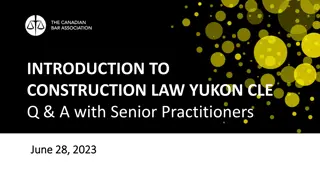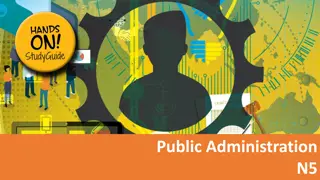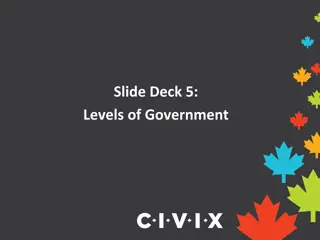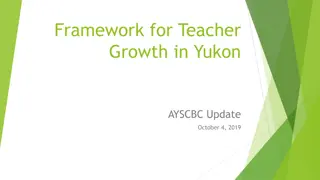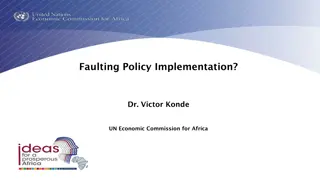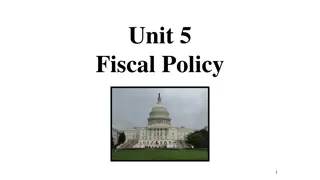Practical Policy Development in the Yukon Government
Policy development in the Yukon Government, led by Colin MacDonald, a Policy Analyst in the Department of Education, involves creating legislation, regulations, and official department policies to guide decision-making. It covers acts, regulations, and the initiation process for new policies driven by various stakeholders. The approach focuses on addressing existing or potential problems through proactive and reactive measures, considering the need for policies on specific issues.
Download Presentation

Please find below an Image/Link to download the presentation.
The content on the website is provided AS IS for your information and personal use only. It may not be sold, licensed, or shared on other websites without obtaining consent from the author. Download presentation by click this link. If you encounter any issues during the download, it is possible that the publisher has removed the file from their server.
E N D
Presentation Transcript
Practical Policy Development in the Yukon Government Colin MacDonald Policy Analyst, Department of Education
Policy outlines the way we do things It is meant to guide decision making and steer people in the right direction It can range from the law to suggestions for best practices. Policy is: Legislation http://www.gov.yk.ca/legislation/legislation/page_e.html Regulations Official department Policies http://www.education.gov.yk.ca/policies-all.html Memorandums of Understanding Guidelines and directives What is Policy?
Acts Regulations Policies Approved by the legislative assembly e.g. The Education Act, the Yukon College Act , Student Financial Assistance Act Approved by Cabinet e.g. Attendance areas, school councils (number of members), Approved by the Deputy Minister e.g. School record policy, concussion policy What the difference?
Something has happened and we must respond. Examples: Moveable Soccer Goals, Guidelines for First Nations Traditional Medicine Reactive How is new or improved policy initiated? We anticipate something that could happen and we take steps in advance. Examples: Eligibility to Vote in School Council Elections, Corporate Sponsorship Proactive
The impetus for developing or improving a policy can come to us in a number of ways: Ministerial direction (e.g. Child Care Subsidy) The civil service (within or outside the department e.g. Yukon College degree regulation) Who initiates new or improved policies? Education stakeholders (parents, students, school councils, CSFY, teachers, school administration, YTA e.g. Video Surveillance Policy) Quasi-judicial and advisory bodies Information and Privacy Commissioner Ombudsman (e.g. Yukon Nominee Policy) Educational Appeal Tribunal Human Rights Commission (e.g. School Trespass Policy) Chief Electoral Officer (e.g. Education Act amendments)
Policies begin with either a problem that needs to be addressed or a possible future problem. The first question to as is what s the problem here? What is the problem? E.g. Student Records Policy and Concussion Policy it is important for us to take a common approach to identified problems.
The first step is to determine if we actually need a policy. We try to not take a highly prescriptive approach and allow people to use their best judgement. Do really need a policy? E.g. Do we need a policy on students and outdoor fire pits?
Identify the extent and dimensions of issue, including historical and political context. Identify the parties and stakeholders affected. Review other options for addressing the issue, prior to deciding a new policy is needed. Identify the implications of proceeding with vs. not proceeding with policy development. Scope of the issue Identify the level of complexity involved and an initial proposed policy process. Identify the general level of Cabinet authorization required and seek approval if needed. Example: Education Act, regulations and policies related to School Council elections
Establish internal team(s) of parties with affected mandates and/or expertise: Technical working group to undertake the work. Senior Steering Committee to provide senior direction (if needed). Build the team Establish external advisory team of parties or stakeholders that are affected (if needed). Define roles, responsibilities, communications and ground rules. Example: Safe and Care Schools and Managing Student Discipline Policy
Define the goals and objectives Work with team(s) to clarify overall policy goals and objectives. Example: Guideline for First Nations Traditional Medicine
Work with teams to clarify issues, interests, ideas, information needs, type of analysis required and resources needed. Define work plan with objectives, processes, tasks, roles, timeframes and products. Define the work plan Determine role of and type of consultation to be used, if any. Determine in detail the stages where Cabinet direction and authorization is needed. Example: Yukon College degree regulation
Collect info on background, relevant technical data, history, trends and context. Review and understand relevant legislation, agreements and commitments. Do the research and analysis Identify issues and interests of different stakeholders and parties (internally and/or externally through consultation, if needed) Analyze the technical and policy implications of issues so they are fully understood. Identify how other jurisdictions have dealt with this policy issue (can we put the dog on it?) Example: Moveable Soccer Goals Safety Act regulations , First Nations Traditional Medicine
Identify options to meet policy objectives and address issues & interests. Assess pros and cons of each option. Identify and assess options Ability to address policy objectives, issues and interests. Consistency with government goals, commitments, laws, policies, prescriptions. Example: Child Care Subsidy
Prepare summary of research, analysis and options. (may be internal paper only, or public discussion paper) Review summary of research and options Review with technical experts re: technical accuracy. (internal) Review with senior management re: political sensitivity. (internal) Consult with stakeholders and public re: public acceptability. (external, if needed) Example: Child Care Subsidy and Moveable Soccer Goal Safety Act
Consult on draft recommendati ons Consult with stakeholders on draft legislation, regulations policy or guidelines Example: School Trespass Policy and the Human Rights Commission, Senior Leadership Team, Policy Advisory Committee Example: Safe and Caring Schools Policy and YTA, FNEC
Work with stakeholders and program level to implement policy. Implement policy Often involves a communications strategy. Example: Corporate Sponsorship Policy






